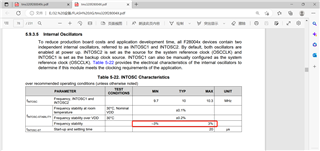Hi
We are facing the issue with the F28004x‘s series's X1/X2 pin damaged.
So we are thinking about using interal oscillator for clock source.
However ,our product uses CAN communication, and the internal oscillator's frequency stability is not good with temperature.
Also it seems that the change of frequency is also no linear ,like 2803x.
Is there a way help us to fix this issue?
Regards
Arrow


